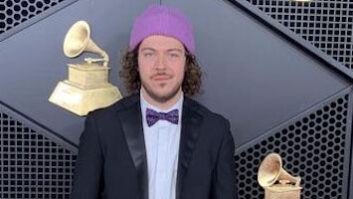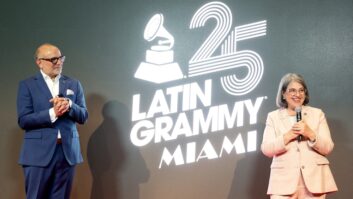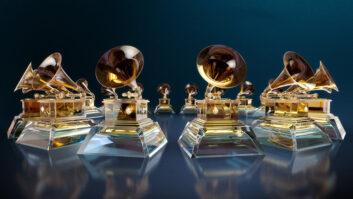
In the six days before rehearsals would begin, the Staples Center in downtown L.A. took on the gravitas of a military operation—a well-planned invasion of 150 stage hands, 17 tractor-trailer trucks with tons of rigging, 130 technicians and an audio crew of 60.
With four days of rehearsals, sound checks, and camera blocking using 23 high-definition cameras, the 57th Grammy Award Telecast has become the largest production of an annual awards show with the most complex audio production in television.

M3 Engineer-in-Charge Joel Singer.
There were 26 songs performed using 23 different setups alternating between A and B stages or both stages together for performances by John Legend, Beyoncé, Madonna and AC/DC’s opening set. Small “Dish” stages out in the audience were also used for smaller setups.
Using the latest and most reliable technologies, the veteran audio crew, under the direction of Audio Coordinator Michael Abbott, deployed the latest in audio platforms and workflows in order to accommodate or exceed the highest expectations of both the artists’ and the in-house and TV audience.
Joel Singer, M3 (Music Mix Mobile) Engineer-in-Charge, notes that his company’s Eclipse and Horizon trucks used Grace M802 remotely controlled microphone preamps with
A/Ds into RME MADI converters out to dedicated fiber to his two music trucks.

Music mixers Eric Schilling, left, and John Harris in the M3 Mobile.
In the two music trucks, Broadcast Music Mix engineers John Harris and Eric Schilling work simultaneously using mirrored Pro Tools 10.3.8 rigs, Avid D-Control mixers and Genelec 5.1 Smart Active Monitoring. Both rigs were in simultaneous, redundant record mode during the dress rehearsal and actual live broadcast.
Harris recorded all rehearsals while the second music truck became available for artists to come in and tweak EQ, compression, static effects and panning with Schilling. Stored as snapshot automation, these settings were used for the live broadcast mix. The broadcast mix was delivered in uncompressed, 24-bit/48-kHz, 5.1 surround format.
About one-third of the artists require the use of some sort of track augmentation—from entire backing tracks to loops, strings, keyboards or backing vocals. However, all lead vocals are sung live and all bands perform live. Pro Tools engineer Pablo Munguia worked in a separate trailer to provide these pre-recorded track elements.

Broadcast production mixer Tom Holmes.
Out in the arena, the FOH music mixer was Ron Reaves, supervised by Leslie Ann Jones of the Recording Academy. Next to the DiGiCo SD7 at FOH was ATK/Audiotek’s Mikael Stewart, FOH Production Mixer, using a DiGiCo SD5 for in-house audio feeds, announcer microphones and playback during commercial breaks.
More than 391 microphones were used, including more than 54 wireless mics, 18 guitar packs, plus 41 wireless in-ear monitors. RF coordination for 300-plus frequencies was the responsibility of David Bellamy of Soundtronics. He explained that he had deployed 28 antennas throughout the arena for maximal coverage. Audio-Technica, Shure and Sennheiser wireless products and systems were all well represented.
In the Denali broadcast truck, Broadcast Production Mixer Tom Holmes provided the finished 5.1 audio mix in real-time, transmitted via embedded audio to CBS-NY. Holmes sits at a Calrec Alpha console to combine 5.1 music mix, audience mics, handheld stage mics, pre-recorded audio from video clips and other sources.
Playback Mixer Eric Johnston plays (pre-approved) pre-recorded music clips the instant the winner is announced, as well as all “bumper” music to and from commercial breaks.
Tasked with providing a compelling soundtrack to the home viewer, superb broadcast audio quality is the result of months of planning and nearly two weeks of on-site preparation by consummate audio professionals at the peak of their game.






